Walker Elliott Rowe's Blog, page 9
April 14, 2016
Taxi Drivers in Chile Protest Uber
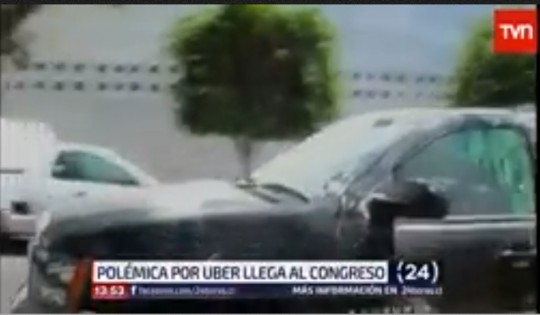
by
Alana Gale
photo: TVN news showing Uber driver’s car damaged by taxi driver assault.
thumbnail photo: “Taxi Pasando” by Betoscopio
14 April 2014. Santiago, Chile. In response to the popularity of Uber, over 2,000 taxi drivers protested in Santiago last Friday, La Tercera reports. The Chilean taxi drivers are not the first to object to Uber: protests have taken place in cities around the world, including París, Sao Paulo, and London.
During the morning, groups of taxis met at O’Higgins Park to form a convoy. The protest was not announced publicly and did not have authorization from the regional government.
The protesters say that Uber and Cabify, a Chilean Uber copycat, are illegal. Andrés Torrejón, president of the Rental Vehicle Owners Association, says that they are fighting for the elimination of what they call these illegal cellphone apps and that the government has done nothing. He says this is hurting the taxi business.
Unlike Torrejón, Luis Reyes, the president of the National Confederation of Chile Taxis maintains that the confederation does not support the protest. He argues that some applications should be legal, like Safer Taxi and Easy Taxi, which ensure that the clients contact taxi companies directly, as opposed to private drivers. Those apps only work with licensed Chilean cab drivers, meaning those who have purchased a medallion, something that is handed out on a limited basis.
However, he does agree with the request for injunction against Uber and Cabify submitted to the Court of Appeals in Santiago on Friday by a group of taxi drivers. He sees those applications as illegal, because the users of the applications do not have permission to transport passengers.
Uber has not commented on the judicial action or the protest. Cabify has only agreed with the need for transportation vehicles to have biannual mechanical equipment checks, which is required of registered taxis.
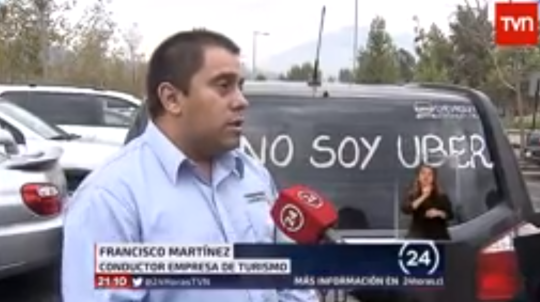
(In the TVN photo above a driver for a commercial transport company writes, “I am not Uber,” after taxi drivers threatened him.)
A spokesperson of the movement, Elvis Venegas, said that the dissatisfaction of the taxi drivers is understandable, because any person who wants to transport people can now do so through Uber or Cabify, without a professional license.
Oriana Fernández of La Tercera explains the difference between the license required for Uber drivers and the one that taxi drivers must have: Uber drivers need only a Class B license, which is a license for 4-wheeled private transportation of at most 9 people. Taxi drivers must have had their Class B license for two years and take a course.
La Tercera explains how the National Confederation of Chile Taxis is trying to formulate its own solution for the problem. The confederation wants to create an application that would serve as a competitor to Uber and Cabify.
Luis Reyes said that 43 different taxi syndicates will present their personal visions for the new system this week. He added that the idea is to utilize technology to better their service.
Pedro Pablo Errázuriz, the former Minister of Transportation under Sebastián Piñera, also has an opinion on the situation. In a follow-up article for La Tercera, Carlos González Isla said the ex minister thinks that laws against applications like Uber and Cabify are not the way to resolve the controversy.
In Errázuriz’s opinion, the government should work to legalize this type of service. Additionally, he thinks that it should be adopted quickly by taxi services because of its efficiency.
As of April 6th, the current Minister of Transportation, Andrés Gómez-Lobo, had no intention of legalizing Uber and Cabify’s means of service, saying to El Mercurio that he had plans to take the “pirated transport” off the road. He said that the system of transportation was pirated because the drivers do not have professional licenses and the vehicles do not have the corresponding safety requirements. Thus, the vehicles, he said, are not qualified for public transportation.
But his stance changed slightly after the protest last Friday. According to La Tercera, he said that the taxi drivers should not have taken matters into their own hands and that he was against the protests. He went on to say that private transportation services like Uber and Cabify need to be registered with the government, have drivers with professional licenses, have the appropriate insurance, and have biannual vehicle inspections. The minister also chastised the cab drivers saying they should adopt technology to improve their service and that he would increase policing of cabbies who have tampered with their meters and who are handing out counterfeit bills as change. He also said he uses the Safer Taxi and Easy Taxi apps to call and pay taxis.
Replying to the Minister, Uber insisted that it was not a taxi company. Consequently, Uber wants a different form of regulation for their type of transportation service.
Then, La Tercera reported that on Tuesday, the Santiago Court of Appeals declared as inadmissible the appeal asking for Uber to be considered illegal.
Other countries have also been dealing recently with the question of Uber, details La Tercera. Mexico considers Uber a new category of transport but requires that the vehicles are registered with the Secretary of Mobility and that 1.5% of the price of each trip be given to a fund to help better taxi services. Brazil is currently taking action to enact strict rules that would make Uber drivers adhere to many guidelines of traditional taxi drivers. Similarly, Uruguay’s government is trying working on a project to regulate the usage of the application.
Despite various opinions on what the solution may be, the legality of Uber and other private transportation applications in Chile remains to be decided by Congress.
Uber launched service in Argentina last week and cabbies protested on the first day. A court there wasted no time in ruling Uber illegal there.
April 12, 2016
Pharmacies and High Drug Prices in Chile
Drug prices in Chile are high. The market is concentrated and now is dominated by foreign owners. Pharmacy executives have been charged with price fixing some years ago, which was not a crime at the time. Insurance does not pay for drugs. The pharmacies are supposed to offer generic medicines in place of brand name drugs. But the health officials say that the drug makers are “boycotting” this system. Consequently it is difficult if not impossible to find generic drugs. Some pharmacies have been caught engaging in the illegal practice of paying their employees to push certain drugs. That was only made illegal a few years ago. Anger over all of this had led to cities creating their own non-profit pharmacies.
The pharmacy market here is dominated by three companies, whose pharmacies dot seemingly every street corner in the capital. These are Sacobrand, Ahumada, and Cruz Verde. There are small independent pharmacies too, but their market share is tiny.
70% of the pharmacies in Chile are foreign owned. A Mexican firm bought 60% of Cruz Verde who controls 41% of the local market. The American giant Walgreens bought Ahumada, who controls 28% of the market. Only Sacobrand is still owned by Chileans.
Anger over drug prices in Chile has led a handful of cities to create non-profit “public pharmacies” (farmacia publics) usually located right inside the municipal offices. These public pharmacies are able to buy directly from the supplier to the hospital system there. So they can offer discounts of 20% to 80%. The government created regulations that made it possible to set up these non-profit pharmacies. The goal is to create them all across the country. There are already a dozen or so in operation. Santiago wants one. The Nuñoa neighborhood in Santiago already has one. And even the major of Viña del Mar, who is a member of the pro-business UDI political party, wants one there too.
Insurance here in Chile does not pay for medicine. And drugs here are sold at world market prices. So they are quite expensive. Some drugs sold here are not available in generic form even though they are sold as generics in other countries.
Many people living on the minimum guaranteed retirement pensions are paying up to 40% of their pension on drug prices.
La Tercera reported that the person in charge of policing the the market here, Felipe Irarrázabal, told a congressional committee that there are impediments to fair pricing here.
He said that local pharmacies cannot compete with the major chains because they do not have the negotiating power. Nor do they have the cash flow to wait for the laboratories to pay their bills. So they are stuck selling only certain brands. And he said there is too much market concentration with the three big chains having control over the vast majority of the market.
Another issue, and one which the pharmacies have been able to block in the legislature, is you cannot buy over-the-counter medicines in any place but the pharmacy. For example, you cannot aspirin in grocery stores.
While he did not specifically say that drug companies are paying doctors to write prescriptions for their drugs he did say that is it necessary to police whether this is the case. Regarding policing in general, he says the prosecutors do not have the resources to do that adequately. Among items that need policing are curtailing the practice called “canela” where pharmacies pay their employees to promote certain drugs. He said there are “sophisticated ways for the pharmacies to skirt the law on that.”
The official criticized the 15 to 20 year period by which drug companies are given a patent over their drug. He said it was obviously necessary to reward drug companies for their innovation and investment but that it needs to be in a “just manner” and not subject to manipulation where the drug companies are able to arbitrarily extend this period of time. Of course practically all drugs are invented by firms in the USA and Europe and not Chilean ones. Those patents are recognized here by international trade treaties. Regarding manufacture, drugs sold here are manufactured in Chile and other parts of Latin America for the most part.
Finally, regarding generic drugs the pharmacies here have signs to remind their customers to ask for low prices generic drugs but when you actually ask for those they tell you they are not available. The prosecutor asks, “The question is how effective has the government been in increasing the availability of generics in order that the situation might be better than it has been.”
Related Articles
April 6, 2016
Rose
 byLouise KantroPhoto by Frédéric Bisson
byLouise KantroPhoto by Frédéric Bisson
Since Bernie’s death nine months ago, Rosie had lost forty-three more pounds, bringing her total to fifty-two. She wasn’t dieting. Even during spurts when she ate like a pig, she told her best friend, Lena, she wasn’t putting on any of the weight she’d lost.
She remembered a time when kids at school had offered her parts of their bag lunches and she’d eaten her own lunch and their leftovers and not gained a pound. This had been one of the two times in her life when she’d been slim: between twelve and thirteen, puberty; and ages twenty-nine to thirty-three, when she was breast-feeding her youngest, chasing her two daughters around all the time, and had joined a gym.
Then twenty pounds came on, and another twenty until – well, she didn’t even admit to Lena what her high was.
Bernie never seemed to care that she had gained so much weight. He saw her for her. Rosie had cared much more than he did, though she never went on that two-year diet she thought she would need to get back to 130 pounds. Yet now the pounds were dropping off.
Bernie had always kept his own weight in check. He was a little overweight, too, but not like she was. The weight loss for both of them had started when Bernie began to waste away. Rosie bought Ensure because Bernie told her his stomach could handle it, and she practically turned into a cheerleader trying to get him to eat. After a while, though, she got it: she could not stop the dying process. Her job was to see the whole thing through with him, right at his side.
They thought he might experience his last day on this earth for more than two months. By the time he died, Rosie was almost relieved. Then she felt a stab of pain at her disloyalty. She did not want him to be dead, but he was, and for his last seven months he had been in horrible pain. She tried to reassure herself that the relief she felt was that he no longer had to suffer. While that was true, it was also true that she was relieved to be done with waiting for The Big Day.
The relief didn’t stop the tears, though. She’d get up, go about the day’s business of shopping, cooking, doing dishes, responding to calls from friends, but after a while she didn’t initiate calls herself. Oh, she’d made the needed calls about the death certificates, two calls to activate his life insurance, and she’d managed to make arrangements for the funeral. Thank goodness the girls helped, but she had made the actual calls. After that, if there was a problem with a bill, she emailed. She chose to drive to the gas and electric company to speak to someone in person instead of trying to explain by telephone. It was an odd kind of compulsive behavior. She had even named it: phonophobia. Said out loud it sounded like something fake, phony, or like she was afraid of the actual phone – which she was not – or even like she was afraid of hearing. None of those interpretations captured her inability to pick up the phone and dial.
Her daughters and Lena caught on pretty quickly to Rosie’s new aversion and made sure they called her on a regular basis. Once in a while they tested her, not calling for a couple of weeks to see if she would call them. Then they would start calling her again.
She had seriously considered her youngest daughter Jeanette’s suggestion that she see a therapist but ultimately decided that this phobia would probably pass in time. She didn’t think about getting counseling or finding a grief group to help her through the mourning itself. In her mind, the telephone was her problem.
Jeanette also seemed to think the weight loss was, as she put it, “worrisome,” mentioning it at the same time she brought up therapy. But really, how could weight loss be a problem for a fat person?
It was when her nephew and his wife invited her to meet them at a restaurant about forty minutes away that Rosie realized she had developed another small phobia: she didn’t want to drive on the freeway. Driving through town was okay, but the idea of merging into traffic going sixty-plus miles per hour terrified her. She made it to the restaurant and back, but she was such a basket case for a full two days afterwards that she decided to allow herself this other tiny phobia. For a while, at least, she would decline future invitations if they involved driving on the freeway.
She told herself that some things had gotten worse: her inability to use the telephone or drive on the freeway, but some had gotten better: she had lost and seemed to be continuing to lose weight and almost overnight her hair had turned silver, a lovely, shiny color with no unattractive green halo.
Rosie was, she decided, a different person now. Bernie would still love her if he were around, but he would have to acknowledge that she was not the same woman he had married.
She wondered if he’d be different, too, until she realized how silly that was. He was dead. He couldn’t change now, in the Afterlife, could he?
She must have meant, she said to Lena later that night when Lena called, that Bernie probably would have become a different man if she’d have died first. It felt like a great insight, though Lena didn’t react much. Rosie, however, laughed for several giddy minutes at the thought of Bernie as a changed man. Might he have shaved off the mustache he’d had since the seventies? Suddenly had the urge to get manicures? Started dating bimbos?
Nix on the bimbos, she told herself. Bernie was not a bimbo kind of guy.
When they hung up, Rosie decided that nobody understood her now, not even Lena, her friend of fifty-one years. It didn’t make her mad or sad. It was simply a fact.
Maybe it was time to have people call her Rose, not Rosie. Not that she talked to all that many people anymore. It was the same name, only without the “i”.
Lena would probably not be able to do it, and it didn’t matter with Sarah and Jeanette, who called her Mom.
Well, she could start thinking of herself as Rose, couldn’t she? She didn’t need to say anything about it. She could spare them the worry. Lots of things about her seemed to worry them, but really, she was coping just fine.
Yes, Rose, she said to herself, practicing the new version of her name. Lena didn’t need to know everything about her. Best if she kept some things to herself.
Louise Kantro is a retired teacher, empty-nest mother, cat-lover, and ball-and-chain to her husband of 44 years. She plays bridge, tends to her 91-year-old mother, and goes to the library every three weeks. Louise volunteers as a court advocate for foster children and collects rejection slips for her stories and poems (except not from us).
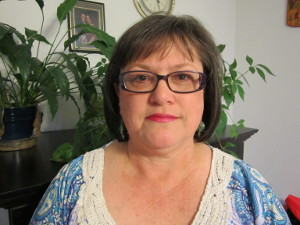
April 1, 2016
Horses and Horseback Riding in Chile

by
Walker Rowe
One irony in Chile is here the poorest people can own a horse but in the USA only the richest can afford that, especially on the East Coast. In the American West it is different.
In 2011, I moved to Chile from Rappahannock County, Virginia, which is the heart of what they call Hunt Country. I took riding lessons at a stables there. Most everyone there rode with the hounds, that is to say they went fox hunting. In the fox hunt 30 to 50 riders put on what looks like tuxedos and took off with 100 dogs or so who are chasing a fox. It’s an English aristocratic sport brought to Virginia, although I believe it is banned in England now, because animal rights people complained.
Even though I bought my house and 65 acre farm for cash in Rappahannock County I was relatively poor. The people who went fox hunting did not have to work every day and owned several horses. Most were older since older people obviously have more money and time that the young. That was ironic too as fox hunting is quite dangerous. Smack into a tree while galloping in the forest or leaping over a fence and you will get killed. I did not ride with the hounds because I did not buy my own horse until I moved here to Chile.
In that part of Virginia horses literally live better than people. They have nicer houses (stables). Or at least some of those that surrounded me were nicer than mine. They were definitely larger.
There are many idle rich people, or indebted professional people and entrepreneurs, who own vast rolling acreage in Rappahannock and Loudon County, Virginia, just outside Washington, DC. They mark off their 100 or 500 acre spreads with wooden fencing. That amount of wood alone would cost more than even an average person’s house. A person who was actually farming such land would use barbed wire fence, which costs a lot less.
The fox hunters have arranged with the landowners there to let their hounds (It’s bad form to call them merely “dogs.”) and riders to cross their property. So some of these hunt clubs have amassed as much as 100,000 acres of contiguous land on which to ride. So where does someone go who does not have their own land or time and money to ride with the hounds? They don’t. They would need to buy their own land, which the poor cannot do. Or they can ride around in a circle at a stable such as eager teenage girls who learn dressage do. So riding is not a sport for the poor or even middle class there.
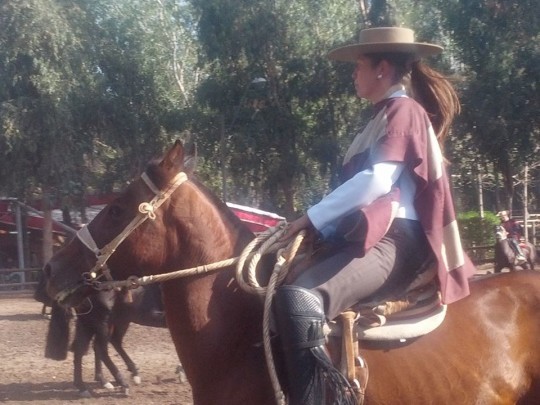
Here in Chile things are quite different. Here you see people riding horses in the road. You see horses working too as people use them to haul carts. That simple access to the public roads lets people go where they wish without having to owning all the land in between. So a rider can pass from one place where they have permission to ride to another or simply ride in the road or in the hills or riverbed or wasteland. You do not need 500 acres of rolling grass pastures. You could not ride a horse in the road in Virginia because the road is too well paved. The cars go too fast and there are lots of blind curves in those rolling hills. Someone would run into you. Perhaps the police would stop you too, yet tractors can drive in the road. It’s supposed to be a public right of way.
In Scotland ordinary people have greater access than in Virginia. There they have an ancient privilege called the Right to Roam. In England they have that too, but politically-connected fishermen were able to recently stop the public from wandering the private trout streams. The Right to Roam lets people cross private property as long as they do not do any damage. So you could ride your horse over dale and hill (Shakespeare said that.) and roam the lonely moors.
It’s not that way in posted-no-trespassing Virginia. It’s not that way here in Chile either, but people in Chile are less likely to complain since the only place you could roam on your horse would be the hills and foot hills or wasteland. All the flat land has fences around it since it’s all planted in agriculture or small 1-2 acre plots with houses. Chilean put fences around all the land, even when it is sort of ridiculous to do so, such as on land on which it is too steep to walk. More about that in a moment.
In the Western United States land is not so expensive, so you do not have to be a billionaire to buy 20 acres to ride a horse. You could buy, say, 20 acres or even less in Arizona or New Mexico and locate yourself next to an Indian reservation or national park and have an endless expanse to ride on. There are national parks in Virginia too, but those are covered with trees and rocky trails which are not a good place to gallop.
In the Western USA horse riding is a completely different culture than Virginia. It’s a different style of riding too that they call Western. That means you use a Western saddle instead of an English one. Although a cowboy might take offense to this statement, Western riding is easier for the beginner. Because the huge leather Western saddle has a saddle horn. It’s supposed to be used to tie off a cow when you lasso it. But it also gives you something to hang onto in case the rider gets out of control.
The English saddle, by comparison, is very small. It has no horn. When you are galloping down a hill in the Virginia mountains it feels like you are flying. And if you do not learn to maintain your balance and hang on with your thighs you will in fact take to their air and fall off.
In Chile they use a type of saddle that I imagine you could simply call Chilean. It has no saddle horn. It’s safer too because the stirrups are wooden and closed on one end. It looks like an actual shoe. So there is no chance that your foot will poke through and you will get dragged to your death as is possible with an English saddle with its iron stirrup.
The Chilean saddle is not all leather either. I think the reason for this must be in part because leather is expensive in a country without many cows. There are cows, but not many as there is not much grass. The Chilean saddle has a padded seat made from wool. The back has a kind of shock absorber looking just like a motorcycle. It has no saddle horn. The strap that passes under the horse are not leather either but cotton, which holds a better grip. The reigns are cotton too. All of this leather is sometimes white as it is not always stained with tannin.
I live in the country west of Santiago where I have a mare. I keep her in a corral in a gated community. Before she lived on a 5 acre farm ringed on all sides with mountains that I was free to roam. The mountains are privately owned here, but no one pays much attention, and you can generally pass. The hills here are steep, but they are only a few hundred feet high. So it’s possible to ride up since they are not the snow covered Andes with no solid place to put a hoof. Out here in the country most of the roads are not paved either. So you can ride seemingly forever. And when the road runs out just ride along the river. The riverbank is public land. In Virginia the riverbank is private.
From here south for 4 hours is the only land in Chile suitable for farming, so it’s flat. Yet there are mountains sticking up everywhere, so there are no wide vistas. Only 4% of Chile’s vast territory is suitable to farming. The rest of it is too steep or too dry. It rains in the south, but that is only suitable for grazing. So if you lived in the south you would find more places to ride and fewer fences since grazing land has more acreage than land given to fruit trees, wine grapes, or vegetables, which is what they grow here.
So no one here has 400 acres of grass pastures on which to ride. First of all it is desert here, with rains only coming in winter. So there is no grass. And because there is such little arable land if you had 400 acres even inch of it would be planted with fruit trees, wine or table grapes, oranges, avocados or something else as it is too valuable to leave fallow. If you went to the north of Chile you could ride in the desert. But no one lives in the desert since it is so dry there is not even one blade of grass. People tend to live along the rivers there where the mountains are so steep you can hardly stand up let alone ride a horse.
In the 1960’s Chile had land reform. Then anyone who had more than 80 hectares (162 acres) had to sell. The idea was to break up the great estates. So lots of people here own lots of little pieces of land. But land that is suitable for agriculture, and has water, is very expensive, much more so than even Virginia. So no one wastes it by riding horses on it, unless it has no water in which it would be worth nothing. If it is not along the irrigation canal or has no water in the well then it is just abandoned. So that would be a good place to ride.
So here a person if they are a farmer are likely to own perhaps 2 acres or maybe 10. That is a small farm as far as Wyoming style horse riding goes. A small farm like that can be profitable. In the USA because there is so much farmland, prices for beef and corn are so low that if you farm corn or cattle you would need a thousand acres and hundreds of heads of cattle to turn a profit. Most rural land in Virginia has cattle, but that is simply to reduce the tax bill. Get it labelled agriculture and the real estate tax drops 80%. As for the horses, they tend to spend most of their time inside the stables. Here it is warm enough to leave the horses outside in winter, but you should cover them with a jacket and move them out of the rain, on the few days when it does rains.
One obstacle to riding here is as everywhere, even Wyoming, fences. Fortunately lots of those fences in Chile have been pushed down by people who wanted to cross, at least in the mountains and hills. There’s not a lot of pressure treated posts here. Those cost money. So fences are often just some tree branch that eventually rots since it is not salt treated. So it falls over by itself or you can tip it over.
Here in the country you can ride on the unpaved roads and ride in the mountains. You can ride paved roads too, just don’t go fast or you horse can slip and crush you. As for the mountains most of them are privately owned. But you quickly learn which landowners will complain if you ride on their land and which will not.
Not all the riders here are poor. There are expensive horses here. This too points to something quite different than the USA: the rodeo. In the USA the rodeo is associated with fighting drinking cowboys who when they are not fighting or drinking are off working some blue collar job. Here the people who ride the rodeo have the most expensive horses and the most expensive looking wives and well dressed children. It’s a genteel sport. Horses for the rodeo are required to be registered horses of the Chilean breed. The average campesino you see riding the shoulder of the highway does not have a registered horse. That just means it does not have papers. It can still be a fine horse.
You can buy an unregistered horse for about $800 USD or less. The average salary in the country is only $6,000 dollars, so that is a lot. You can buy a registered horse for $2,000 to $30,000. I pay $15 per month to keep my horse at a stable and $30 for someone to feed it every day. It would costs hundreds of dollars in Virginia for that.
In a land with no rain you need to buy alfalfa, ordinary grass does not have enough nutrients. Alfalfa looks like grass, but it is a legume, like beans. So it is rich in nitrogen. In grass-rich Virginia people do not usually give their well-fed horses alfalfa as it would make them fat. Here a bale costs about $4. One bale lasts three days.
So in Chile horseback riding is a more democratic sport even if the gap between the rich and poor is enormous. For tourists and city people who want to ride horses there are some places you can rent a horse outside Santiago. But where’s the fun in that? You need to own one and ride it a lot so you can learn to gallop and turn and dash among the fruit trees in an orchard and go up and down steep hills. Going fast is a lot more fun that trail riding or going with a guide.
March 28, 2016
Abortion Debate in Chile
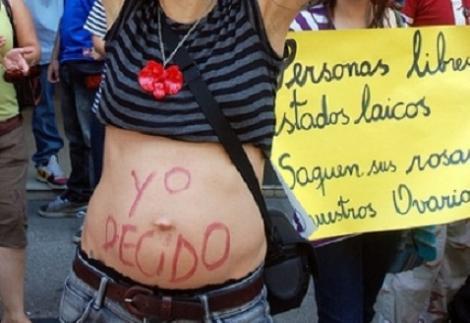
by
Alana Gale
In the photo from El Desconcierto the woman has written “my choice” on her stomach.
Since 1989, Chile has had a blanket ban on all forms of abortion. According to the penal code, any form of abortion is considered a felony that is punishable by up to ten years in prison.
Yet, women still get abortions. Despite a lack of survey data, the Guttmacher Institute reports estimates of between 60,000 and 300,000 abortions each year in Chile. Writing here two years ago, George Allen says women seek out these abortions in different forms: clinics that practice abortion clandestinely, “back-alley” abortions performed by strangers without medical licenses, or a drug called Mistoprostol.
Chilean president Michelle Bachelet of the Socialist Party wants to offer Chilean women a different option for getting an abortion. BBC news wrote about the president’s announcement in January 2015 of a bill that would make abortion legal within the first 12 weeks of pregnancy on three grounds: when the mother’s life is at risk, when the fetus would be stillborn, or in the case of rape.
Though there have been 12 other bills to decriminalize abortion since 1991, they were all tabled by the congress. The congress has two houses, the House of Delegates and the Senate. Both would need to approve a bill for it to pass.
President Bachelet’s bill has already entered the National Congress. As of March 18th, it had passed through the House of Delegates with all three provisions, reported El Mundo. The vote for protecting the life of the mother was 67 in favor, 43 against. The second case—stillborn fetus—was approved 62 over 46, with two abstentions. Finally, the result for abortions in the case of rape was 59 in favor and only 47 against, with three abstentions.
However, the debate over the bill is far from over. After the passage of the bill in the House of Delegates, President Bachelet made a speech about her hopes for further advancement on this issue, said La Tercera.
The next step for the bill is to make its way to the Senate for approval. Another La Tercera article details how it will first be analyzed by the Health Committee in the Senate, and later by the Senate’s Constitutional Committee.
Writer for La Tercera, Macarena Vega explains that the time the bill will spend in these two committees is unknown. María Fernanda Carrasco, also writing in La Tercera, reported that the government has said that they will not put pressure on the Senate, because they recognize the need to look at the bill thoroughly.
Only after the bill is dealt with in these committees will it be presented to the full Senate. It needs needs 20 votes of the 38 senators to pass.
Debate about the bill among the political parties has been very heated. The governing coalition consists mainly of the Christian Democratic Party (DC), the Socialist Party (PS), and the Communist Party (PC), though there are several smaller independent parties included as well. The opposition is the National Renewal (RN) and the Independent Democratic Union (UDI).
The opposition, opposes the bill.
For example, El Mostrador cites UDI member Ignatio Urrutia saying that the bill was akin to murdering fellow human beings. He said he hoped the supporters of the bill would “go straight to hell” when they die.
Likewise, Claudia Nogueira, also of the UDI party, asserted that the bill was a setback for protecting the unborn, reports Yahoo News.
Lawmakers in favor of the bill posit arguments such as that of the Secretary General and SP member, Marcelo Díaz, who thinks the bill is about opening up options for women. Díaz believes it is unfair to punish and criminalize women who find themselves in the situations represented in this bill, says La Tercera. Another lawmaker, Camila Vallejo of the CP, insisted that if men could give birth, then abortion would have been legalized a long time ago.
The centrist DC party is divided over the issue. The DC party chairs both the Health Commission and the Constitutional Commission in the senate. The former will be the first in the Senate to consider the bill.
Senator Carolina Goic, who presides over the Health Commission, has been careful not to vocalize her position, though in the past she has objected to the approval of clause regarding cases of rape.
The leader of the Constitutional Commission, Pedro Araya, has doubts about both the still born fetus and the case of rape.
Other members of the DC party also remain ambivalent about various parts of the bill. Their positions will play an important role in the success or failure of the bill in the upcoming days.
Chile Congress Debates Abortion

by
Alana Gale
In the photo from El Desconcierto the woman has written “my choice” on her stomach.
Since 1989, Chile has had a blanket ban on all forms of abortion. According to the penal code, any form of abortion is considered a felony that is punishable by up to ten years in prison.
Yet, women still get abortions. Despite a lack of survey data, the Guttmacher Institute reports estimates of between 60,000 and 300,000 abortions each year in Chile. Writing here two years ago, George Allen says women seek out these abortions in different forms: clinics that practice abortion clandestinely, “back-alley” abortions performed by strangers without medical licenses, or a drug called Mistoprostol.
Chilean president Michelle Bachelet of the Socialist Party wants to offer Chilean women a different option for getting an abortion. BBC news wrote about the president’s announcement in January 2015 of a bill that would make abortion legal within the first 12 weeks of pregnancy on three grounds: when the mother’s life is at risk, when the fetus would be stillborn, or in the case of rape.
Though there have been 12 other bills to decriminalize abortion since 1991, they were all tabled by the congress. The congress has two houses, the House of Delegates and the Senate. Both would need to approve a bill for it to pass.
President Bachelet’s bill has already entered the National Congress. As of March 18th, it had passed through the House of Delegates with all three provisions, reported El Mundo. The vote for protecting the life of the mother was 67 in favor, 43 against. The second case—stillborn fetus—was approved 62 over 46, with two abstentions. Finally, the result for abortions in the case of rape was 59 in favor and only 47 against, with three abstentions.
However, the debate over the bill is far from over. After the passage of the bill in the House of Delegates, President Bachelet made a speech about her hopes for further advancement on this issue, said La Tercera.
The next step for the bill is to make its way to the Senate for approval. Another La Tercera article details how it will first be analyzed by the Health Committee in the Senate, and later by the Senate’s Constitutional Committee.
Writer for La Tercera, Macarena Vega explains that the time the bill will spend in these two committees is unknown. María Fernanda Carrasco, also writing in La Tercera, reported that the government has said that they will not put pressure on the Senate, because they recognize the need to look at the bill thoroughly.
Only after the bill is dealt with in these committees will it be presented to the full Senate. It needs needs 20 votes of the 38 senators to pass.
Debate about the bill among the political parties has been very heated. The governing coalition consists mainly of the Christian Democratic Party (DC), the Socialist Party (PS), and the Communist Party (PC), though there are several smaller independent parties included as well. The opposition is the National Renewal (RN) and the Independent Democratic Union (UDI).
The opposition, opposes the bill.
For example, El Mostrador cites UDI member Ignatio Urrutia saying that the bill was akin to murdering fellow human beings. He said he hoped the supporters of the bill would “go straight to hell” when they die.
Likewise, Claudia Nogueira, also of the UDI party, asserted that the bill was a setback for protecting the unborn, reports Yahoo News.
Lawmakers in favor of the bill posit arguments such as that of the Secretary General and SP member, Marcelo Díaz, who thinks the bill is about opening up options for women. Díaz believes it is unfair to punish and criminalize women who find themselves in the situations represented in this bill, says La Tercera. Another lawmaker, Camila Vallejo of the CP, insisted that if men could give birth, then abortion would have been legalized a long time ago.
The centrist DC party is divided over the issue. The DC party chairs both the Health Commission and the Constitutional Commission in the senate. The former will be the first in the Senate to consider the bill.
Senator Carolina Goic, who presides over the Health Commission, has been careful not to vocalize her position, though in the past she has objected to the approval of clause regarding cases of rape.
The leader of the Constitutional Commission, Pedro Araya, has doubts about both the still born fetus and the case of rape.
Other members of the DC party also remain ambivalent about various parts of the bill. Their positions will play an important role in the success or failure of the bill in the upcoming days.
March 19, 2016
HBO GO Streaming Coming to Chile

by
Alana Gale and Walker Rowe
Netflix came to Chile a couple of years ago, now HBO is coming this year.
In 2010, HBO launched its streaming service HBO Go in the United States. At first it required that customers also pay for a cable subscription. But in a move that rocked the cable television business, HBO last year joined Netflix in offering access without requiring cable.
Now HBO Go is coming to Chile. The only question is exactly when. They already launched their service in Mexico and Colombia. Their executives have said that the rest of Latin America is on the schedule for sometime in 2016. But they announced in October 2015 that they were coming to Colombia, yet there was a delay of several months.
While Netflix is first to market and, in fact, the only one in the market internationally, HBO could draw a lot of customers too with its 2,500 title inventory including its highly acclaimed original programming.
The biggest draw of all, of course, is “The Game of Thrones,” which is, at the moment, the most watched, pirated, and commented show in the world, according the media accounts.
Lack of Infrastructure in Chile and Local Content
How will HBO fare in Chile? How has Netflix done?
Chileans are far behind the USA and other developed nations in cutting the cable cord or just having a streaming service plan and cable too. The Statistics Portal shows that in 2014 only 230,000 Chileans were subscribed to Netflix’s streaming services. In contrast, 39.1 million people in the USA are signed up.
There are lots of reasons why streaming has not caught on more deeply with Chileans. One reason it is not widely advertised—ironically Netflix would have to turn to regular TV to do that or just get the newspapers to write about their programming—and none of the popular Chilean TV series are available there. The other issue is the lack of broadband coverage. And they need to accept debit cards.
There is high speed internet in Chile, as long as one lives in a city. But for everyone else, in Chile, whose geography is difficult, lots of people do not have even have a broadcast TV signal. So they pay for expensive cable or satellite service. And for those who do not live where there is cable or a land line telephone there is often no cell service beyond the center of towns and along the highways. (You can see where there is cell coverage worldwide on OpenSignal.)
Also, due to the lack of any real competition in the cellular market here there are no unlimited cellular plans, except for one rural plan offered by Entel. It is capped at 1 Mbps speed. That is slow. You need 5 Mbps to watch Netflix in HD. Yet that plan has no unlimited data usage, which is what you need so that you do not use up all of that streaming TV. No other cellular plan in Chile currently has unlimited data.
In the USA not only can you get unlimited internet via the cellular system, it is is available at 4G/LTE speed. In Chile there is not even 4G/LTE in most locations. Most of the country still uses the older, slower 3G system. 4G/LTE works at an average of 20 Mbps which is even faster than the average speed of cable internet in Chile.
Chilean Local Content
On Netflix when you pick the Latin American movie category, you are offered the choices of Mexico or Argentina. There are series from those countries as well, and Colombia, plus the highly rated Gran Hotel from Spain.
Yet regular Chilean broadcast TV is not on Netflix. Plus it is in upheaval right now too. Channels have cut popular new programs that did not have a large rating leaving educated viewers wondering where to view those. And the flagship government channel, TVN, has laid off half their staff and replaced their director after she made some bad bets on TV series that did not do well.
There are lots of fiercely competitive channels here, like Canal 13, Chilevision, Mega, La Red, and, of course, TVN. Regarding international programming, Fox has a Latin channel and people closely follow Homeland on FX and watch HBO and series like The Big Bang Theory.
But in the last couple of years Chilean series have fallen behind imports. Those costs less for the channels to broadcast than to make their own. TVN used to produce lots of excellent shows like, La Reserve de la Familia. But in the past three years Mega has lead the ratings with shows imported from, of all counties, Turkey. So TVN added a new series from Brazil rather than risk money on another flop.
Regarding watching TV online, here you can watch all of the regular channels over the internet, unlike in the USA where local affiliates would complain about that as they do not want to damage local advertising. But what you cannot do online in Chile is replay those on demand on their websites and none of the Chilean content is on Netflix, except the occasional film, like El Bosque del Karadima, about Chile’s most notorious Catholic priest child abuser.
The other thing too is those websites do not use the same streaming software as Netflix (Even though Netflix gives their software away for free.). So their broadcast does not work well over a slow speed connection leaving a jerky viewing experience. Netflix works great over a slow internet connection as they have figured out how to throttle the screen resolution to match the speed.
Netflix Adding Spanish Language Original Content
Netflix no longer just broadcasts content created by someone else, which is what they did for many years. Those who are familiar with the Emmy-winning The House of Cards and Orange is the New Black know that. But now, Netflix is producing original content in languages other than English too.
The first Netflix series in Spanish was Club de Cuervos, made in Mexico. It is a comedy about a brother and sister who inherit a popular soccer team from their father and have disagreements over how it should be run.
Netflix is now making their second Spanish language series, The Rivals. This one stars Kate del Castillo (profiled in The New Yorker here), confidant of cartel king Joaquín Guzman and actor Sean Penn whose visit to Guzman in Mexico led the police to capture the fugitive.
Because of that, the actress is having difficulty filming there as the Mexican police want to talk to her over money laundry charges related to her relationship with the drug kingpin. So she is hanging out at her home in Los Angeles, frustrated, as The New Yorker says, over her inability to crack the American market.
Ms del Castillo has worked with Chilean TV. She starred in the series Los Dueños de Paraiso with Jorge Zabaleta, a Chilean heartthrob actor. The series was a co-production with the American giant Telemundo and TVN Chile. The show did not do too well in Chile, where it was kicked off prime time. It did better in the USA Spanish language market. Now you can watch it on Netflix.
(Aside: Kate del Castillo became famous for her role in La Reina del Sur, where she played a powerful drug trafficker. Someone should write an essay, perhaps us, about how pathetic it is that so many of the leading TV shows in Mexico have been about drug traffickers, like that show, El Cielo de Los Cielos, and others. It perhaps shows some character flaw, dark side of that culture. Their Nobel-prize winning poet, Octavio Paz, said Mexican are obsessed with death. Mexicans should instead laud their greatest actor, , whose roles in black comedies are usually 5 star. That said, Netflix has produced an excellent series about Pablo Escobar, in English, Narcos. And there is a Spanish-language version from Colombian TV that is quite good too.)
One good thing for those who are still learning Spanish is that equal access laws and custom require that American producers add subtitles to their shows so deaf people can watch. That means you can watch Spanish content with Spanish subtitles to help you understand that.
Finally, as another example, in France, Netflix has created Marseille starring France’s greatest, albeit faded, star Gerard Depardieu.
What are the Other Broadcasters Planning?
The international roll out of streaming TV is slowed by existing contracts between content producers and cable and broadcast firms. You can see that as what is available on Netflix varies by country. That lead to such odd arrangements as you cannot see the Netflix-produced House of Card in Germany on Netflix, only on broadcast TV. (This website claims to keep an updated list of what Netflix offers in each country.)
Consider the BBC. Their programming, like Doc Watson and Mr Selfridge, is popular in the USA, where Americans tend to think that anyone with a British accent is somehow sophisticated.
The BBC has an enormous inventory of TV and film. Trying to grow their revenue in the vast American market, the government owned broadcaster is going online in the USA. There are no announced plans to broadcast in any other country, yet.
What the BBC or any broadcaster would need to do to do that, is fix all the legal agreements, then add Portuguese and Spanish subtitles and audio and gear up to accept credit cards in local currencies since dollar-denominated credit cards or any credit card at all are hard to get for those who do not earn a lot of money. But Netflix has solved all of that with no apparent difficultly. Although Netflix does not take Chilean debit cards. Most Chileans only have debit cards and not bank-issued credit cards. The only cards they have are retail store ones, which is why they have so much debt. In Mexico, customers are allowed to go to a store and pay in cash.
The other big streaming services in the USA are Hulu and Amazon Prime. Hulu is not going international, period. They are too closely tied to and owned by the broadcast and cable channels who fear death due to declining revenues at the hands of cable-cutting streaming customers. They already have contracts to broadcast contents all over the world on cable and satellite where they make their money from advertising. HBO Go and Netflix do not have ads.
Amazon is also sticking with the USA market for now. The company is notoriously tight-lipped about its future plans. Yet they already have local versions of Amazon.com store in France, German, Spain, the UK, and elsewhere. And, like Netflix, Amazon has started to produce their own series, including the hit Alpha House starring John Goodman.
Finally, ESPN is joining the movement to go online. Sling TV in the USA broadcasts that and CNN (One wonders if the Cable News Network will have to change their name. People who witnessed the birth of that and cable television, with TBS, remember when it was called the Chicken Noodle Network.).
That ESPN is doing this, lots of analysts say, signals the ultimate death of cable TV. (They have said that before, and it has not come to pass, yet.) But Chile is going to be some years behind with regards to the death of cable monopolies. First, they need to install faster internet to even catch up with the status quo in Europe, the USA, and developed parts of Asia. And then they need to sell locally-produced content to Netflix or put it online themselves so that people get used to streaming content of any kind. Then Chileans can understand that on the internet you can watch what you want to when you want to and not when the broadcasters want to show it.
March 15, 2016
Chile’s Salmon Sector Faces Another Crisis
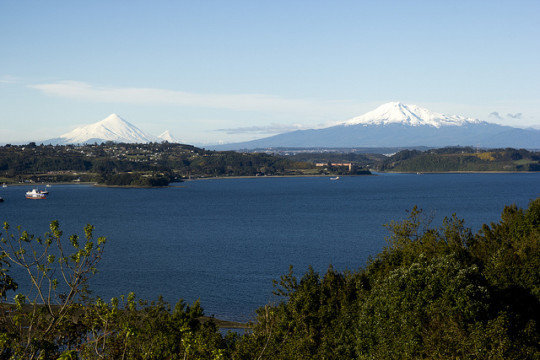
by
Alana Gale
photo “Seno de Reloncaví” by Nicolás Binder.
15 March 2016. Santiago, Chile.
According to La Tercera, an increase in the amount seaweed caused the death of 1.5 million salmon in Reloncaví Sound in Chile, or “District 2,” as it is known by the salmon industry. The news, which came from Camanchaca, a Chilean organization dedicated to sustainable salmon farming, was based on data given by Chile’s Supervision of Security and Insurance (SSI). The SSI works to keep the public informed about the markets it oversees.
At first, the incident seemed isolated, but that changed quickly. On the 29th of February—four days after the report of the initial 1.5 million deaths—the organizations Blumar, AquaChile, and Australis Seafood said that their locations in District 2 were also being affected. The next day, Marine Harvest released the same announcement.
The seaweed causing this widespread outbreak of deaths is known as Chattonella Raphidophyceae, writes Cecila Yañez in a follow-up article for La Tercera:
The presence of the seaweed decreases the concentration of oxygen in the water, damaging the fishes’ gills and thus killing them. Though this outcropping of seaweed occurs every year, it is usually not to the same extent. This is in part due to the high water temperatures caused by El Niño, which has been especially strong this year, and in part due to the high amount of sunlight, which aids in the plant’s photosynthesis process.
Currently, the amount of dead fish exceeds 13 million, which is equivalent to 26 thousand tons of salmon. The industry believes that the effect on production could rise even further—up to 90 thousand tons. Of the 22 organizations in District 2, twenty reported that the phenomenon was influencing them, and the damage even extends to Districts 3 (in Calbuco) and 7 (south of Chiloé Island).
The crisis could become even bigger than the outbreak of the Infectious Salmon Anemia Virus (ISAV) in 2007, which resulted in losses of $600 million US dollars, and around 16 thousand employees. The virus even left many businesses in the industry on the verge of collapse. One source from the industry told La Tercera that District 2 has around 20 million fish and it wouldn’t surprise him if most of them were lost.
So what effect will this have for Chile’s salmon industry?
Chile is the second largest producer of salmon in the world, surpassed only by Norway. Yet last year most of the Atlantic salmon, which is Chile’s biggest export, was sent out at low prices. The low prices are reflected mainly in the US market, where the average cost of Atlantic salmon was $3.70 per pound, while in 2014 it averaged $4.60 per pound.
The change in price was brought about by the currency depreciation in two main markets (Russia and Brazil), as well as by a high production.
However, the deaths caused by the seaweed could actually cause the price of Chilean salmon to rise again. Another source from the salmon industry noted that people were asking for a reduction in volume of salmon from Chile, and Mother Nature might just have provided that reduction.
All of its effects aren’t so positive, though. The low prices of salmon had led the industry to anticipate a loss of more than 2,000 jobs, but, given this crisis, that number could rise even further.
Outside the salmon industry, some scientists are skeptical of the explanations that the industry attributes to the growth of the seaweed. Hector Kol, biologist for a Chilean organization devoted to the preservation of Pumalin Park, thinks that the salmon are dying because the industry puts an exorbitant amount of chemicals into the sea. He explained to La Tercera that the industry put insecticides in the water to protect the fish against an outbreak of caligus, or sea lice. But, said Kol, the sea lice are a natural means of controlling micro-algae, so the industry disrupted the biological equilibrium by dumping pesticides in the water.
Two scientists from Chile’s University of the Lakes, Sandra Ríos and Alejandro Buschmann, have a slightly different idea of what is causing the mortality of the salmon. They believe that the cultivation of salmon impacts biodiversity. Buschmann described how the cultivation of salmon generates carbon and phosphorus that joins with the nitrogen in the water. This, in turn, leads to a loss of oxygen in the water that can cause environmental problems, such as the growth of unwanted seaweed.
Regardless of the cause, both the scientists and the salmon industry are waiting to hear what the final impact of the event will be.
March 14, 2016
Puertecillo
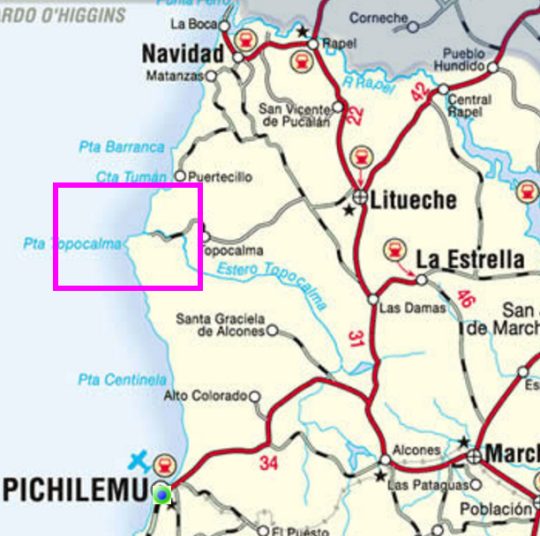
graphic source: Turismo Virtual
Foreign and Chilean surfers already know about Pichilemu and the waves at Punto Lobos. But there is another beach in this area with the same constant swell, yet almost no people: Puertecillo and Punto Topocalma. Puertecillo is the name of the village and Punto Topocalma (Topocalma Point) is the name of the beach and point.
The coastline here is starling in its beauty. The road to the beach drops straight down from the heights of the forest. So most people descend that with 4×4 vehicles. Yet you can use 2-wheel drive. Just make sure you park with one wheel on the sidewalk down in the village least you sink into the sand. There is no parking here as there is hardly any town. Instead there are a few restaurants, a Pentecostal Church, and maybe 50 homes tucked behind the black sand beach, situated dangerously at the level where a tsunami could wash over all of that, as it did in 2010. (If one comes, the cliffs behind the town are too steep to climb. So follow the Tsunami exit signs and walk up 1/2 km north.)
The beach here, like at Pichilemu, is black sand. The surf break is at the point of Punto Topocalma about 1 km walk from Puertecillo. The sand is soft, so walking in that will leave you legs feeling like rubber on the way back. So lots of people use ATV vehicles.
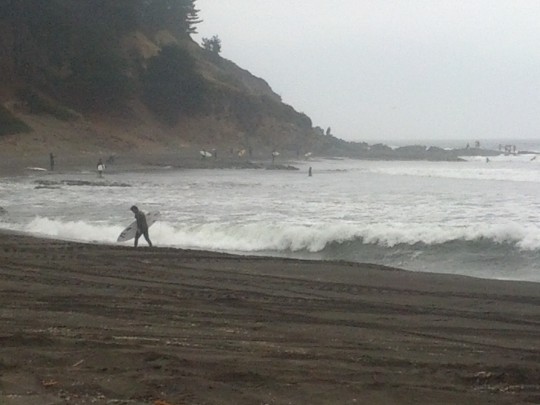
Puertecillo is an upper-class beach. In Chile the beaches are distinctly divided between working class and middle upper to upper class, as is the whole country. The two rarely overlap. It seems every person here in Puertosilla is a 30 year old quika (Chilean slang for upper class woman) with her quiko husband driving an expensive 4×4 quiko truck with a couple of well-dressed quiko children in tow. Lots of these women and men are blond, which labels them right away as coming from the moneyed classes in this country of black-headed people.
The beach here, like a lot of the coast of Chile, is foggy at times, often for long periods of time. Go 10 km inland and there is bright sun. But it’s not cold, even in winter, as the ocean and the cliffs trap this area in a cool but not cold micro climate. The water is freezing. You can swim in it from January to March without a wet suite. Just do not think about it being cold and the cold will not bother you. If you swim you will most likely be the only person in the water except perhaps for a topless European or two or maybe a completely nude Chilean female. But it’s not a nude beach, as there are not enough people in the water or lounging in the sand to call it a beach at all. So you have all that sand to yourself to run around naked if you want.
Chilean people as a rule do not swim. There are few swimming pools here unlike, say, Arizona, where every single house has one, so every kid can learn. The ocean current is too strong so it is not safe to let your children play in the surf. The only safe places to swim are in caletas (harbors) of which there are none on this lonely stretch of empty beach.
One odd thing about Chile is while the coast is so long, the people all pile themselves on top of one another in the same beaches. From San Antonio north to Con-Con is one long densely packed stretch of beaches and the major cities of Viña del Mar and Valparaiso. But Puertecillo is all by itself with Matanza being another lonely coastal village that is not too far.
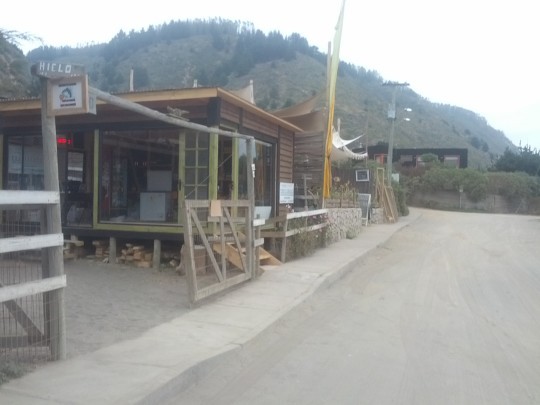
One wonders why there are no beach towns south of the port city of San Antonio all the way to Pichilemu. The answer is there are no roads, or at least any paved ones, except in Navidad. You cannot drive from San Antonio to Puertecillo. You need to go inland via Litueche to do that.
Just a few years ago you could not get to the beaches at Topocalma and Puertecillo because there was no road. Plus you had to ask permission of the landowner who owns the forest. But now you can get there since 5 years ago developers ran electric lines across the vast Topocalma forest and build a quality, albeit unpaved road hoping to make money by selling lots, of which there are a precious few, like only 100. So it will never be crowded.
The Topocalma forest (Fundo) is a private land holding of many tens of thousands of hectares of Eucalyptus trees belonging to the family who owns the Paris department stores. (Interesting historical footnote: in the 1960’s, long before the Communist government, Chile forced landowners holding more than 80 hectares to sell. The goal was to transfer land from the land barons to ordinary people. But over time the land barons have bought some of this back. The working class people who bought these, or who took those, did not always have a lot of success turning a profit on that, so they sold them back.)
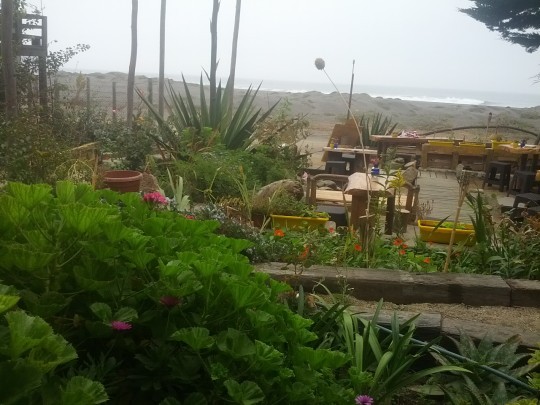
To get there you drive from Litueche on the unpaved, sandy, yet well-made roads. Follow the new electric transmission wires as there are few signs as the hippies who long claimed this beach as their own have defaced many of those to keep the tourists way. You will not find this beach town name on Google Maps, but you can use that to orient yourself.
There are a few tourists here and a few more Chileans. The only town of any size, Navidad, has 5,000 people. It is not close to Puertosilla and not visible. No one lives in Punto Topocalma, which is just a name, yet, although a developer has built some well-constructed roads and is selling parcelas (lots) for $125 million Chilean pesos ($190,000 USD).
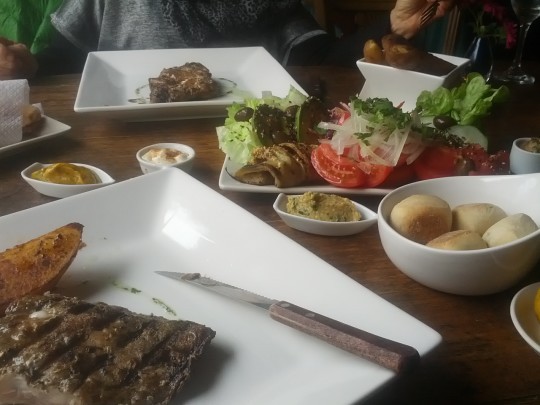
Where to Dine, Where to Stay: La Cantina Gourmet restaurant (phone +56.9.9374.2035) is open 9 months of the year. They have several handsome rooms for rent. Like most businesses, the restaurant closes for the Chilean winter from June to August. After Semana Santa (Holy Week) at the end of March expect this and every other place in town to be almost empty, except surfers will still be there. The La Cantina Gourmet gourmet restaurant features top chefs imported from Santiago for the season. Try the Robalo fish, which is native to these waters. You might see some men fishing in the surf for those near the rocks at the north end of the beach, where a small stream runs out to sea. At this restaurant you can lounge on the bean bag chairs surrounded by cactus or lay back completely on something that looks like a bed and watch raucous small children dismantle the furniture while their parents dine inside. The restaurant also has a bar, Capitán Freí, down the street where you can enjoy gourmet sandwiches under a tiki light and a bon fire surrounded by a garden of succulent plants and native Chilean flowers.
Puertecillo, Chile

graphic source: Turismo Virtual
Foreign and Chilean surfers already know about Pichilemu and the waves at Punto Lobos. But there is another beach in this area with the same constant swell, yet almost no people: Puertecillo and Punto Topocalma. Puertecillo is the name of the village and Punto Topocalma (Topocalma Point) is the name of the beach and point.
The coastline here is starling in its beauty. The road to the beach drops straight down from the heights of the forest. So most people descend that with 4×4 vehicles. Yet you can use 2-wheel drive. Just make sure you park with one wheel on the sidewalk down in the village least you sink into the sand. There is no parking here as there is hardly any town. Instead there are a few restaurants, a Pentecostal Church, and maybe 50 homes tucked behind the black sand beach, situated dangerously at the level where a tsunami could wash over all of that, as it did in 2010. (If one comes, the cliffs behind the town are too steep to climb. So follow the Tsunami exit signs and walk up 1/2 km north.)
The beach here, like at Pichilemu, is black sand. The surf break is at the point of Punto Topocalma about 1 km walk from Puertecillo. The sand is soft, so walking in that will leave you legs feeling like rubber on the way back. So lots of people use ATV vehicles.

Puertecillo is an upper-class beach. In Chile the beaches are distinctly divided between working class and middle upper to upper class, as is the whole country. The two rarely overlap. It seems every person here in Puertosilla is a 30 year old quika (Chilean slang for upper class woman) with her quiko husband driving an expensive 4×4 quiko truck with a couple of well-dressed quiko children in tow. Lots of these women and men are blond, which labels them right away as coming from the moneyed classes in this country of black-headed people.
The beach here, like a lot of the coast of Chile, is foggy at times, often for long periods of time. Go 10 km inland and there is bright sun. But it’s not cold, even in winter, as the ocean and the cliffs trap this area in a cool but not cold micro climate. The water is freezing. You can swim in it from January to March without a wet suite. Just do not think about it being cold and the cold will not bother you. If you swim you will most likely be the only person in the water except perhaps for a topless European or two or maybe a completely nude Chilean female. But it’s not a nude beach, as there are not enough people in the water or lounging in the sand to call it a beach at all. So you have all that sand to yourself to run around naked if you want.
Chilean people as a rule do not swim. There are few swimming pools here unlike, say, Arizona, where every single house has one, so every kid can learn. The ocean current is too strong so it is not safe to let your children play in the surf. The only safe places to swim are in caletas (harbors) of which there are none on this lonely stretch of empty beach.
One odd thing about Chile is while the coast is so long, the people all pile themselves on top of one another in the same beaches. From San Antonio north to Con-Con is one long densely packed stretch of beaches and the major cities of Viña del Mar and Valparaiso. But Puertecillo is all by itself with Matanza being another lonely coastal village that is not too far.

One wonders why there are no beach towns south of the port city of San Antonio all the way to Pichilemu. The answer is there are no roads, or at least any paved ones, except in Navidad. You cannot drive from San Antonio to Puertecillo. You need to go inland via Litueche to do that.
Just a few years ago you could not get to the beaches at Topocalma and Puertecillo because there was no road. Plus you had to ask permission of the landowner who owns the forest. But now you can get there since 5 years ago developers ran electric lines across the vast Topocalma forest and build a quality, albeit unpaved road hoping to make money by selling lots, of which there are a precious few, like only 100. So it will never be crowded.
The Topocalma forest (Fundo) is a private land holding of many tens of thousands of hectares of Eucalyptus trees belonging to the family who owns the Paris department stores. (Interesting historical footnote: in the 1960’s, long before the Communist government, Chile forced landowners holding more than 80 hectares to sell. The goal was to transfer land from the land barons to ordinary people. But over time the land barons have bought some of this back. The working class people who bought these, or who took those, did not always have a lot of success turning a profit on that, so they sold them back.)

To get there you drive from Litueche on the unpaved, sandy, yet well-made roads. Follow the new electric transmission wires as there are few signs as the hippies who long claimed this beach as their own have defaced many of those to keep the tourists way. You will not find this beach town name on Google Maps, but you can use that to orient yourself.
There are a few tourists here and a few more Chileans. The only town of any size, Navidad, has 5,000 people. It is not close to Puertosilla and not visible. No one lives in Punto Topocalma, which is just a name, yet, although a developer has built some well-constructed roads and is selling parcelas (lots) for $125 million Chilean pesos ($190,000 USD).

Where to Dine, Where to Stay: La Cantina Gourmet restaurant (phone +56.9.9374.2035) is open 9 months of the year. They have several handsome rooms for rent. Like most businesses, the restaurant closes for the Chilean winter from June to August. After Semana Santa (Holy Week) at the end of March expect this and every other place in town to be almost empty, except surfers will still be there. The La Cantina Gourmet gourmet restaurant features top chefs imported from Santiago for the season. Try the Robalo fish, which is native to these waters. You might see some men fishing in the surf for those near the rocks at the north end of the beach, where a small stream runs out to sea. At this restaurant you can lounge on the bean bag chairs surrounded by cactus or lay back completely on something that looks like a bed and watch raucous small children dismantle the furniture while their parents dine inside. The restaurant also has a bar, Capitán Freí, down the street where you can enjoy gourmet sandwiches under a tiki light and a bon fire surrounded by a garden of succulent plants and native Chilean flowers.



